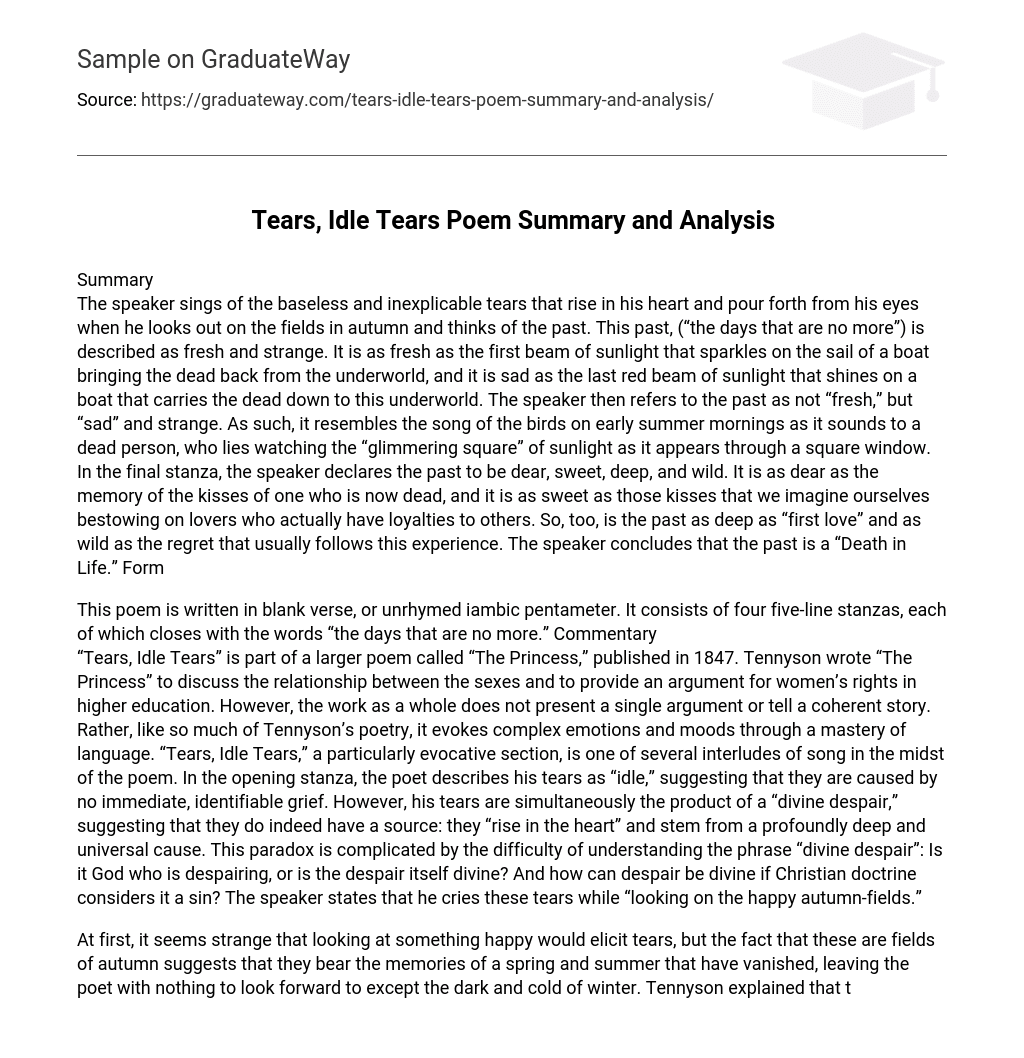Summary
The speaker expresses their inexplicable tears and sadness when they think of the past while looking out on the autumn fields. The past is described as fresh and strange, like the first beam of sunlight on a boat bringing the dead back from the underworld and as sad as the last beam of sunlight on a boat carrying the dead down to the underworld. The speaker also compares the past to the song of birds on summer mornings, sounding like it does to a deceased person who watches sunlight appear through a square window. In the final stanza, the speaker declares the past to be dear, sweet, deep, and wild. It is as dear as the memory of kisses from a deceased person and as sweet as imagining kissing someone who is committed to someone else. The past is also as deep as first love and as wild as the regret that usually follows that experience. Ultimately, the speaker concludes that the past is like a death in life.
Form
This paragraph discusses Tennyson’s poem “Tears, Idle Tears.” The poem is written in blank verse, specifically unrhymed iambic pentameter. It consists of four five-line stanzas, with each stanza ending with the phrase “the days that are no more.” “Tears, Idle Tears” is part of the larger work “The Princess,” published in 1847. This work aims to explore gender relationships and advocate for women’s rights in education. However, it does not present a singular argument or clear story; instead, it uses language to evoke complex emotions and moods. Within this poem, the first stanza describes tears as both “idle” and originating from a “divine despair.” This contradiction raises questions about the source and nature of these tears while challenging traditional Christian beliefs regarding despair as a sin. Furthermore, these tears are shed by the speaker while observing joyful autumn fields.
The presence of tears when looking at something joyful may appear strange initially. However, the fact that these tears are caused by autumn fields suggests that they hold memories of a vanished spring and summer. This leaves the poet with nothing to anticipate except for the dark and cold of winter. Tennyson gained inspiration for this poem while at Tintern Abbey, which is near Hallam’s burial place. William Wordsworth also wrote a famous poem titled “Tintern Abbey” which reflects on the passage of time and the loss of youthful joys. Whereas Tennyson mourns “the days that are no more” and describes the past as a form of “Death in Life,” Wordsworth explicitly expresses that despite the past being gone, he has received compensation with “other gifts”: That time is past,
And now all the aching joys and dizzy raptures of life are gone and I do not faint, mourn, or complain about it. Other gifts have come in place of such loss, and I choose to believe that they are abundant compensation.
Both Wordsworth and Tennyson write poems about the passage of time at Tintern Abbey. However, Wordsworth’s poem expresses satisfaction while Tennyson’s poem conveys sorrow. In “Tears, Idle Tears,” Tennyson structures the poem using unique adjectives to portray memories of the past. The second stanza follows a chiastic pattern with the adjectives “fresh…sad…sad…fresh.” The beginning of friendship is described as “fresh,” while the loss of those friends is depicted as “sad.” Thus, when the past is described as both “sad” and “fresh,” these words already have deep meaning and associations, evoking memories of thriving and dissolved friendships. This stanza also includes an image of a boat traveling to and from the underworld, reminiscent of Virgil’s portrayal of Charon, who transports the dead to Hades. In the third stanza, the memory of the past is described as “sad…strange…sad…strange.” The adjective “sad” emerges through the depiction of a dying man awake for his last morning. Nevertheless, strangeness arises because it is peculiar that as his life comes to an end, a new day begins.
The twittering of birds holds an exceptional meaning to a person who will never hear it again. It becomes filled with melancholy tones that resonate for the first time, although paradoxically, it is also their last. As the poem reaches its climactic lament, the final stanza floods us with a wave of descriptive words: “dear…sweet…deep…deep…wild.” The repetition of “deep” reminds us of the profound despair that brings tears in the first stanza. Yet, the speaker is also consumed by regret for the irreplaceable days that have passed. The image of a “Death in Life” evokes memories of lost friends, like submerged recollections resurfacing only to fade away once more. This “Death in Life” also recalls the experience of dying amidst the rebirth of morning. Therefore, the poet’s fervent exclamation in the last line signifies the culmination of the previously developed imagery.





